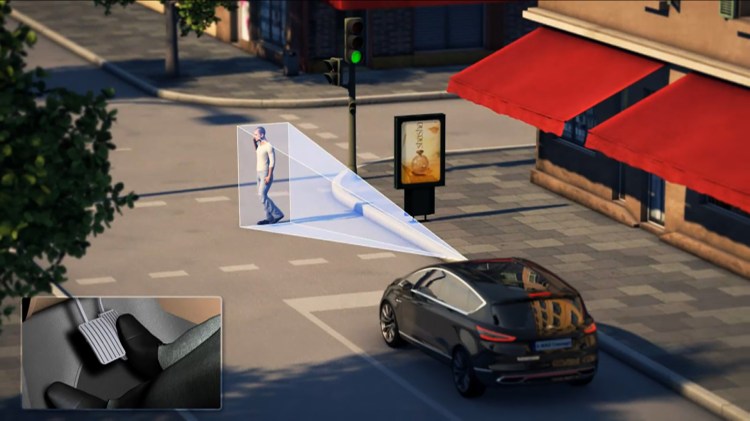New technology from Ford’s European researchers could one day help you avoid collisions — or squeeze into a tight parking space — with the help of radar, ultrasound, and a digital camera.
Its new Obstacle Avoidance technology scans the road up to 200 meters (656 feet) ahead, using a combination of three radar units, ultrasonic sensors, and a camera. If it detects a slow-moving or stationary object, such as a pedestrian, it displays a warning and sounds a chime.
If you don’t steer away from the obstacle or slow down enough to avoid it, the car will take over, using its sensors to find a safe gap, then steer you into it or hit the brakes, preventing the collision.
Ford of Europe researchers have installed a prototype of the system in a Ford Focus and has tested it at speeds up to 38 mph. Ford is also working with 29 other partners to extend the technology, through a research project called “interactIVe” (which Ford says stands for Accident Avoidance by Active Intervention of Intelligent Vehicles, though that would actually spell out AAAIIV).
At the same time, Ford has announced it’s working on an automated parking technology that enables the car to park itself. To use it, you’d press and hold a “Park” button, and then just sit back as the car rolls down the row of parking spaces, locates an empty spot, and then parks itself.
Ford says the technology, which it has tested in a single vehicle so far, could allow cars to self-park at the somewhat alarming speed of 18.6 mph, squeezing into spots just 20 percent longer than the vehicle itself. A demo video shows the car parking itself in a 90-degree spot that’s not especially narrow, but if it can do parallel parking into a space that’s only one-fifth longer than the car, I’ll be truly impressed.
But the real advantage of self-parking may be in squeezing into 90-degree spots that are so narrow you’re unable to open the door. Ford says this technology could work even if you’re not in the car, so you could get out of the car before you’re wedged into that spot and trying to crawl out an open rear window.
While these two technologies are still in the lab stage, Ford already offers a parallel-parking assistance tech called Active Park Assist that enabled this rather hair-raising video of a car self-parking on the roof of a parking garage, right next to a 90-foot sheer vertical drop. It also offers an adaptive cruise control that adjusts your car’s cruising speed to that of other vehicles around it, and is working on all kinds of in-vehicle technologies to enhance the driving experience.
Of course, Ford is not the only company working on self-driving and driving-assistance technologies. Google has so far led the charge to develop self-driving cars, and its autonomous vehicles can regularly be seen on freeways and in parking lots around the Bay Area. Nissan, General Motors, and Tesla are also all reportedly working on self-driving cars.
VentureBeat's mission is to be a digital town square for technical decision-makers to gain knowledge about transformative enterprise technology and transact. Learn More






